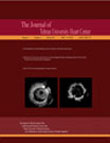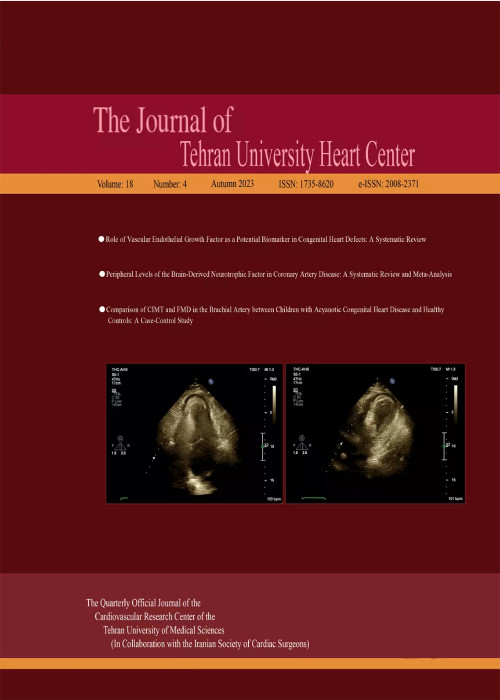فهرست مطالب

The Journal of Tehran University Heart Center
Volume:13 Issue: 1, Jan 2018
- تاریخ انتشار: 1396/12/09
- تعداد عناوین: 10
-
-
Pages 1-5BackgroundStandard coagulation screening tests are important constituents of basic examinations in clinical laboratories. There is no clear evidence of a relation between the type of clinical presentation and coagulation parameters in patients with suspected coronary artery disease.MethodsThis cross-sectional study included 539 patients who underwent coronary angiography in Tehran Heart Center between November 2012 and January 2013. Patients presented with ST-segment-elevation myocardial infarction (STEMI), non-STEMI, unstable angina, or stable angina. Prothrombin time (PT), international normalized ratio (INR), and activated partial thromboplastin time (APTT) were measured before angiography and compared between the clinical presentation groups.ResultsThe mean age of the patients was 59.156 ± 11.05 years, and 47.7% were male. STEMI was reported in 41(7.6%) patients, non-STEMI in 42 (7.8%), unstable angina in 304 (56.4%), and stable angina in 152 (28.2%). No difference in the mean PT and INR was found between the groups. The mean APTT was significantly lower among the patients presenting with STEMI and non-STEMI (26.58 ± 2.32 ms in the STEMI, 26.85 ± 2.41 ms in the non-STEMI, 27.64 ± 2.54 ms in the unstable, and 27.93 ± 2.53 ms in the stable angina groups, respectively, p value = 0.005). After adjustment, the association between the patients presentations and APTT was significant (OR for 5 ms increase in APTT = 1.661, 95% CI = 1.184 to 2.332; p value = 0.003).ConclusionWe observed that the patients who presented with STEMI had the lowest value of APTT, whereas those who presented with stable angina had the highest. The value of APTT in patients undergoing coronary angiography may have a potential to predict the extent and severity of coronary stenosis.Keywords: Blood coagulation tests, Partial thromboplastin time, Prothrombin time, Coronary artery disease, Myocardial infarction
-
Pages 6-12BackgroundBased on the protective health model, one of the most important components of etiological factors leading to protective health behaviors is perceived risk or perceived susceptibility. Accordingly, the present study was conducted to assess the uncontrolled and controlled effects of some factors in predicting perceived susceptibility among coronary artery bypass graft (CABG) patients.MethodsThe data for the present cross-sectional study were gathered via assessment of 1052 CABG patients who referred to an outpatient cardiac rehabilitation clinic in a hospital in Iran between 2010 and 2014. The patients completed a checklist containing demographics, risk factors, and a single closed-ended question regarding perceived susceptibility at the beginning of their rehabilitation program. Binary logistic regression analysis was applied to identify the demographic and clinical correlations related to perceived susceptibility.ResultsTotally, 776 (73.8%) of the 1052 participants were male. The mean age of the patients was 58.0 ± 9.1 years. The results revealed that only 13.7% of the patients had perceived susceptibility; in addition, higher age (p value = 0.003) and family history of cardiac diseases (p value = 0.001) were able to significantly predict perceived susceptibility. When the demographic variables were controlled, once again age and family history of cardiac diseases were able to significantly increase perceived susceptibility by approximately 1.04 and 29.6 times, respectively.ConclusionOur results revealed that higher age and family history of cardiac diseases were able to significantly predict perceived susceptibility among our CABG patients.Keywords: Coronary artery bypass, Perception, Risk factors
-
Pages 13-17BackgroundEnhanced external counterpulsation (EECP) reduces angina pectoris, extends time to exercise-induced ischemia, and improves quality of life in patients with symptomatic stable angina. We aimed to evaluate the effects of EECP on heart rate recovery in patients with coronary artery disease (CAD).MethodsBetween January 2011 and March 2013, a total of 34 consecutive patients (24 male, 70.6%) with symptomatic CAD, who were candidated for EECP, prospectively received 35 sessions of 1-hour EECP therapy per day, 6 days per week. The patients underwent echocardiography and a symptom-limited modified Bruce exercise test before and after EECP. Left ventricular ejection fraction (LVEF), resting and peak exercise heart rates, systolic blood pressure, heart rate at 1 and 2 minutes of recovery, exercise duration, workload, and first- and second-minute heart rate recovery were measured before EECP and compared with those after EECP.ResultsThe mean age of the patients (70.6% men) was 64.82 ± 8.28 years. After EECP, exercise duration increased significantly from 6.48 ± 2.76 minutes to 9.20 ± 2.71 minutes (p valueConclusionThe results of the present study showed that exercise duration, maximum workload, and the LVEF might increase significantly after EECP. The increase in the first- and second-minute heart rate recovery after EECP was not statistically significant.Keywords: Coronary artery disease, Counterpulsation, Angina pectoris, Heart rate
-
Pages 18-23BackgroundTissue Doppler imaging yields useful information about regional myocardial function. The purpose of this study was to investigate myocardial function by strain and strain rate in a group of patients with congenital heart disease (CHD) before and after cardiac surgery.MethodsThree consecutive tissue Doppler echocardiographic examinations were performed on 25 patients with CHD, who underwent open-heart surgery. The study was conducted from April 2013 to April 2014 in a university hospital, and the assessments were done 1 day before and 1 week and 1 month after surgery. The effects of demographic variables, types of anomalies, and cardiopulmonary bypass factors on strain were evaluated.ResultsThe study population comprised 13 female and 12 male patients at a mean age of 9.4 ± 9.8 years. Compared to the preoperative data, repeated measurements of strain in 9 segments of the ventricles showed a significant reduction 1 week after surgery, followed by a significant augmentation 1 month postoperatively (p value = 0.001 for all 9 segments). The reduction in strain at the middle segment of the left ventricular free wall was significant in the cyanotic patients (p value = 0.037). The increase in strain at the middle segment of the septum and the right ventricular basal and middle segments was significant (p value = 0.021, p value = 0.015, and p value = 0.021, respectively) in the patients with a shorter pump time.ConclusionOur patients experienced an early decline in myocardial function after cardiac surgery, but their myocardium recovered its contractility gradually.Keywords: Cardiac surgical procedures, Echocardiography, Doppler, Elasticity imaging techniques
-
Pages 24-26Inflammatory myofibroblastic tumors (IMTs) of the lung are rare solid tumors and usually affect children and young adults. We describe an unusual form of an IMT of the left lower lobe invading the left atrium. A 9-year-old male patient with recurrent cough was referred for an evaluation of left-lung pneumonia. Transthoracic needle biopsy was performed, and the histopathological examination showed mixed inflammatory cells. Accordingly, an IMT was considered. Left lower lobectomy was performed. A portion of the tumor invading the left atrium was resected together with the intact atrial wall. The postoperative period was uneventful, and the patient was discharged on the sixth postoperative day.Keywords: Lung neoplasms, Heart atria, Child
-
Pages 27-31In patients with cardiac resynchronization therapy (CRT), loss of left ventricular (LV) stimulation occurs chiefly because of LV lead dislodgement. The occurrence rate of LV lead dislodgement in different reports is between 2% and 12% of patients. LV lead dislodgement precludes clinical improvement. We describe 2 patients with heart failure, fulfilling the criteria for CRT implantation. In both patients, right ventricular and right atrial leads were implanted via the left subclavian vein in the right ventricular apex and the right atrial appendage, respectively. Repeated LV lead implantation was unsuccessful and each time after the fixation, the LV lead was dislodged with the heart motion during systole and diastole. In order to stabilize the LV lead, we decided to benefit from coronary sinus stenting and lead entrapment behind the deployed stent. LV lead stabilization was accomplished by the deployment of bare-metal stents (Multi-Link 3.5 × 8 mm and Multi-Link 3 × 8 mm, Abbott Vascular) in order to entrap the LV lead. The stents were deployed at a nominal pressure (10 atm). The pacing performance of the LV leads was satisfactory and stable at midterm in our experience. Stenting within the coronary sinus seems to be a safe method for LV lead stabilization and can substantially boost the success rate of CRT. Our device analysis during short- and midterm follow-up (4 months after implantation) revealed acceptable LV lead threshold and impedance.Keywords: Cardiac resynchronization therapy, Stents, Angioplasty, Coronary sinus
-
Pages 32-34A circumflex artery originating from an ostium apart from the left main artery is one of the most common coronary artery anomalies. However, a dual origin of the circumflex artery is an extremely rare anomaly. We describe a 55-year-old male patient admitted to our clinic with the diagnosis of unstable angina. Angiography revealed twin circumflex arteries: one from the left main artery and the other from the proximal right coronary artery and a stenotic left anterior descending coronary artery (LAD). The patient was treated with percutaneous coronary intervention on the LAD lesion. His overall condition was good at 2 weeks follow-up.Keywords: Coronary angiography, Coronary vessels, Coronary vessel anomalies
-
Pages 35-37Coronary artery aneurysms are rare findings in patients referred for coronary angiography. Their prevalence ranges between 0.2% and 6% in different case series. We describe a male patient with a huge left main coronary artery aneurysm causing exertional angina, which was diagnosed with coronary angiography. All of the left coronary system arose from the aneurysm. He underwent coronary angiography again, followed by multislice computed tomography with a three-dimensional reconstruction. Although there is no known standard treatment modality for such aneurysms, we planned medical therapy after consultation with the cardiovascular surgery department. The patients first visit was in March 2013, and he was thereafter followed up until September 2016.Keywords: Coronary vessel anomalies, Coronary aneurysm, Multidetector computed tomography


